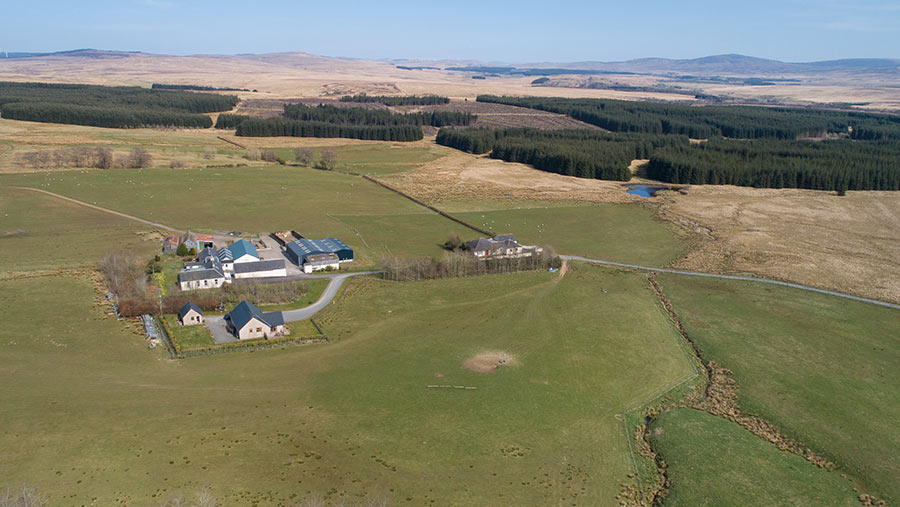What’s the market like for farms with natural capital?
Natural capital has moved to the forefront of farmers’ minds in recent years, with new support schemes and grants focusing on environmental objectives.
Interest in a limited supply of properties with opportunities for public goods, tree planting and carbon credits from a wide range of buyer types has driven both demand and prices.
Buyers are looking to plant commercial forests, create native woodland, restore peat, diversify habitats and install wind turbines, as well as seeking productive farmland and sporting prospects, say agents.
See also: Private sales rise in popularity to near 50% of land market
New buyer type
Scottish agent Galbraith says demand for land for natural capital and rewilding is boosting the market, which was already benefiting from the booming forestry sector.
Demand outstrips supply by a considerable margin, with only about 15 estates changing hands in a typical year.
Average prices are increasing, alongside significant premiums being paid for hill farms and planting land.
Hill ground, until recently priced at £600-£800/acre, can now sell for more than double this value, particularly where natural capital potential exists.
Emma Chalmers, partner at Galbraith, says: “The sales of Glenlochay Estate in Stirlingshire in 2019 and Auchavan Estate in Angus in 2020 both prompted a number of natural capital buyers to come forward, alongside those who were primarily interested in traditional pursuits.
“However, the sale of Kinrara Estate earlier this year saw the majority of potential buyers with interests in woodland creation and natural capital above all else. This was further experienced when a stock farm was marketed and sold privately, also earlier this year, with a natural capital buyer secured.”
Buyer types include corporations, institutions, investment houses and private individuals with a variety of motivations and interests, according to Galbraith.
As has been reported with the wider market, the proportion of private sales has increased considerably.
“With the accelerating understanding of climate change, we are seeing a growing desire to offset carbon usage, both personally and by business,” says Ms Chalmers.
“The need to be more visibly green or meet net-zero targets means the traditional estate, together with hill and stock farms, is attracting increased interest from this new natural capital purchaser.”
Evolving sector
Evelyn Channing, Savills head of rural agency in Scotland, says the market for commercial tree planting is very buoyant, with a number of large funds chasing suitable land.
At the other end of the scale, where commercial tree planting may not be suitable or permitted, there is definite interest in land suitable for native tree planting that may be eligible for carbon credits.
“Demand is up across the board, with people looking to buy rural property for all types of reasons,” says Ms Channing.
“In Scotland, 17% of new registered buyers are interested in land suited to environmental and tree-planting opportunities.”
There is a very limited number of opportunities for properties that offer tree-planting potential or other environmental angles, so interest is strong when one does become available.
Factors affecting land values include soil types, access to timber roads, rainfall, the existence of degraded peat (which could be eligible for peatland restoration projects), the depth of peat, and habitat diversity.
“Natural capital and environmental investment is a new and evolving market and it is too early to say if it will grow or diminish in the future,” says Ms Channing.
“The climate crisis is not resolved and land use is likely to be part of that solution, but we feel we are five years away from knowing the real direction of travel.”
What’s on the market?
Farming and forestry

© Savills
The Auchenlongford Forestry portfolio in Ayrshire is on the market with Savills for offers in excess of £8.25m.
It includes a 569-acre stock farm, 1,463 acres of commercial forestry, two residences, salmon fishing and the potential for peatland restoration.
It is available as a whole or in five lots.
Property with potential

© Goldcrest Land & Forestry Group
Near Inverness, in Inverness-shire, Goldcrest Land & Forestry Group is selling 1,200-acre Saddle Hill for offers in excess of £950,000.
The unit comes with open heather moorland, Caledonian pine trees, three burns, a lochan and the potential for peatland restoration, tree planting and rewilding.
